One year since signing his five-year contract to become Bayern Munich head coach, Julian Nagelsmann has revamped and subtly restyled the squad he was appointed into. With friendlies, not always a clear indication of a team’s strength and style for the upcoming season, the DFL Supercup was the first match in the domestic competition to compare the Bundesliga champions against one of the title contenders for next season, RB Leipzig.
Using the 5-3 DFL-Supercup final, this tactical analysis will dissect the new Bayern system shining a light on their fluid, high-pressing attack to their vulnerability in transitions, as Die Roten starts their second season under Nagelsmann.
Lineups
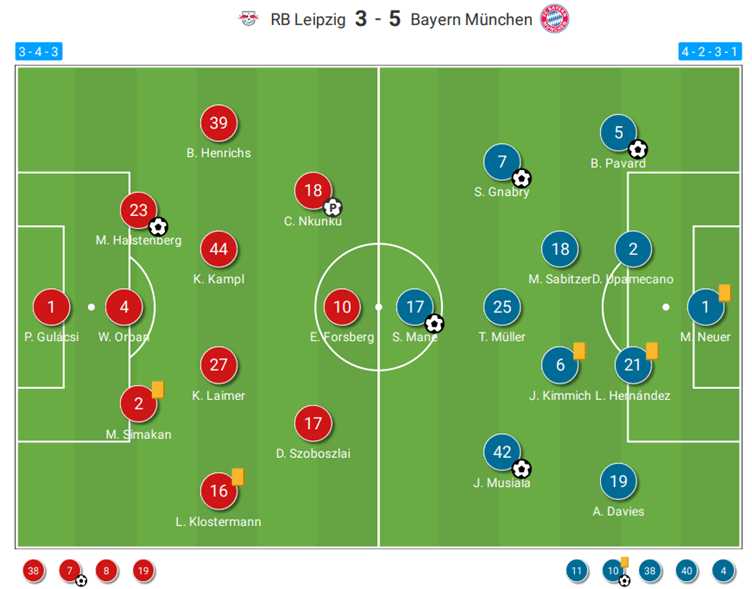
Bayern started the match in their normal 4-2-3-1 from last season, which is the first time during the pre-season. The personnel in the starting eleven also looked very similar to the previous campaign but, with Goreztka injured, it allowed Sabitzer to reinstate himself into Nagelsmann’s side. Jamal Musiala and Serge Gnabry started, providing the fluidity and creativity in attack to work interchangeably with new signing Sadio Mane.
Substitutions during the match saw wingers Coman and Sane replace Musiala and Gnabry respectively, followed by the trio of Ajax academy graduates who joined this summer. The current squad is unquestionably strong, with the depth to go deep in multiple competitions. The ex-RB Leipzig manager demonstrated the versatility of his system, changing to a 4-2-2-2 or 4-4-2 after the 68th minute, with Mane and Sane leading the line.
RB Leipzig also stuck to their trusted 3-4-2-1 formation, with the focus on defensive solidity in the centre of the pitch. Die Roten Bullen have made little impact so far on the transfer market as they selected a familiar starting eleven. The bigger transfers for the club were Xaver Schlager and David Raum for a combined total of £35 million, along with the numerous loan players returning. Domenico Tedesco looks happy with his current squad, with the aim to hold onto Josko Gvardiol after rejecting a £67 million bid from Manchester City for the Croatian centre-back.
Fluidity in attack
With the departure of one of the best goalscorers in the world, Bayern Munich had a big Lewandowski-shaped hole to fill in the attack. There are still questions about whether the Bavarian side will look to sign another striker in the transfer window. However, Nagelsmann has been open about his comfort in the options of Sadio Mane, who can play on the wing or as a centre-forward, and Eric Maxim Choupo-Moting, who is a reliable player with the ability to link up play and score goals.
Since the arrival of Mane, Nagelsmann has been able to remodel the Bayern system to suit his high intensity and interchangeability across the front line. The fluidity this grants Bayern in the attack was overwhelming for Leipzig because of the numbers Bayern could get forward and the unpredictable movement in the final third.
The second goal for Bayern demonstrated the new look attack, with the front three in different positions than they started in. The mix of intelligent off-the-ball movement and incredible passing put a chance on a silver plate for Die Roten’s new Senegalese striker.
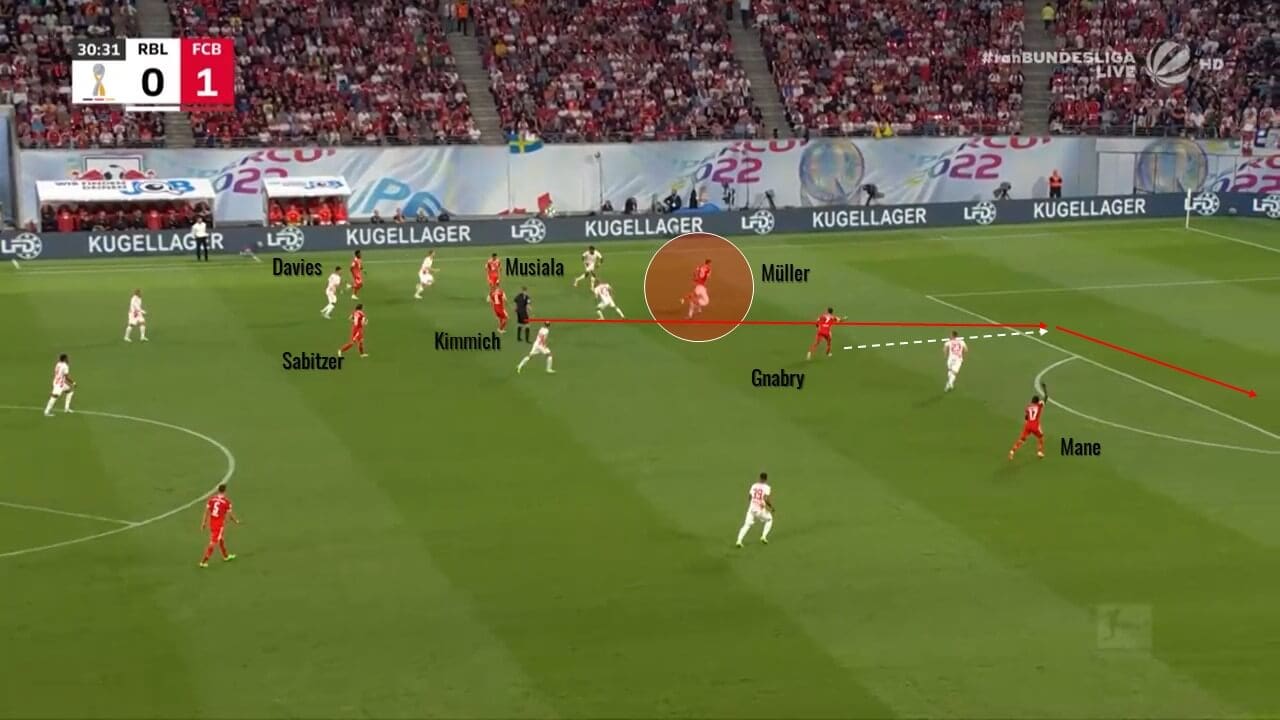
Müller was a key part of the goal, setting the ball off for Musiala and creating the gap for Joshua Kimmich to thread a ball through for Gnabry. After controlling the ball in the box, Gnabry played a simple ball across the front of the six-yard box for Mane to slot home. The quality of the pass to pick out Gnabry, along with the awareness of each player in the final third to create this chance, was exquisite.
Bayern were creating chances with ease and entered the Leipzig penalty area 25 times in the match with 4 entries from crosses and 5 from runs into the box. Nagelsmann’s new attack completed almost all of the 28 accurate passes into the final third into penalty box entries which illustrates the effectiveness of this well-oiled system.
The freedom which Nagelsmann has given to his team enables them to split defences open and is the backbone of their unpredictability. The 35-year-old head coach is keen to get numbers forward when attacking, as seen frequently from Pavard down the right-hand side and slightly less so by Davies on the left. The run within the right half-space from Pavard in the penultimate move before the opening goal shows the exact type of impact Nagelsmann is looking for when his fullbacks join the attack.
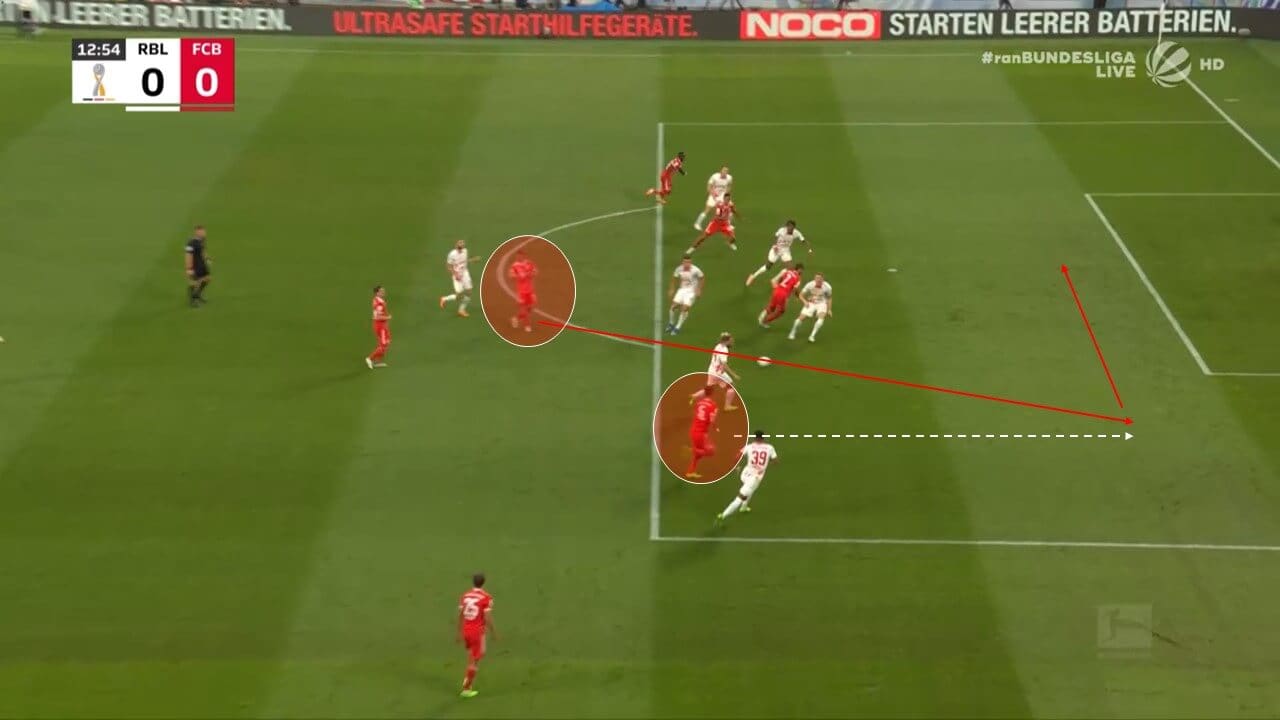
Once again, Müller opens up the space for the run beyond the Leipzig backline as he stretches the pitch. Pavard directs his run inside the wingback, Henrichs, as simultaneously Kimmich slides a ball into the path of the Frenchman. From here, Pavard pulls his cross too close to the retreating Leipzig backline as it goes out of play for a corner, but this opportunity is a pattern of play that Bayern look to create.
Even with the unpredictability around the box, there is a pattern to most of Bayern’s chances. Almost identical to the previous two chances that have been taken from the match, Bayern had yet another chance, this time with their substitutes on the pitch.
The common concept to the penalty box entries is with a central player playing the ball out into the half-space with the runner able to play the ball back into the centre of the box, as seen in the second example. Or in this and the first example, with the ball being played by the wide midfielder after they have cut inside to pass the ball within the half-space onto a diagonal run from a player in the striker position.
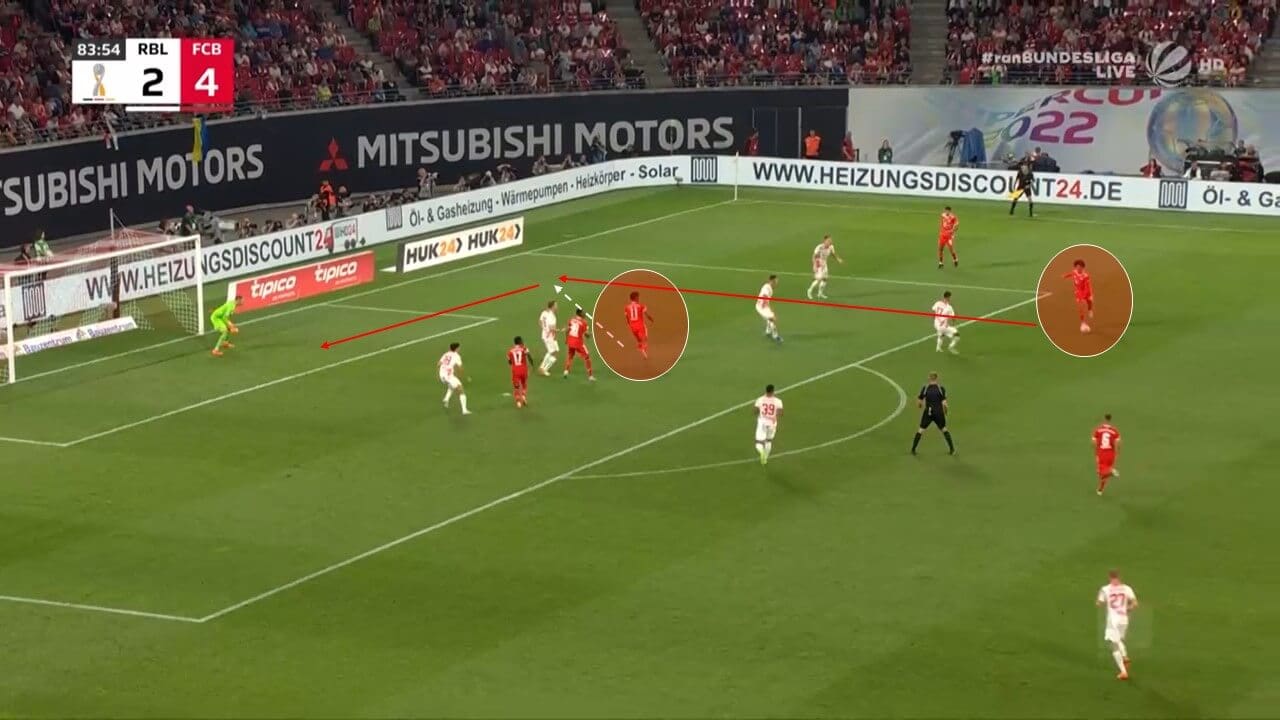
Coman’s run in front of a preoccupied defender is very difficult to stop with it being a 3v2 in Bayern’s favour in the centre of the penalty area. Mane’s movement is also interesting to note as he had dropped deep earlier in the move to start the attack and finished the chance only to be offside. His impact on the Bayern style of play comes with his speed and work ethic which the ex-Liverpool striker brings to the number 9 position.
Getting players forward is something that Bayern have excelled at under Nagelsmann. This is not only a component of his side in possession but it is also a feature of the high press Bayern deployed throughout the match.
High Press
Bayern’s press was troublesome for Leipzig for the duration of the match as the Bavarian side had a PPDA of 6.8. The high press is not a new feature to the Bayern side from last season as they average around 8 PPDA during the competitive campaign.
Bayern are not worried about pressing the ball high up the field as they are confident in their midfield and defence to win the long ball if the opposition chooses to go down the line. This is a brave tactic as this can expose spaces in between the defensive shape as players move out of position to close down the ball.
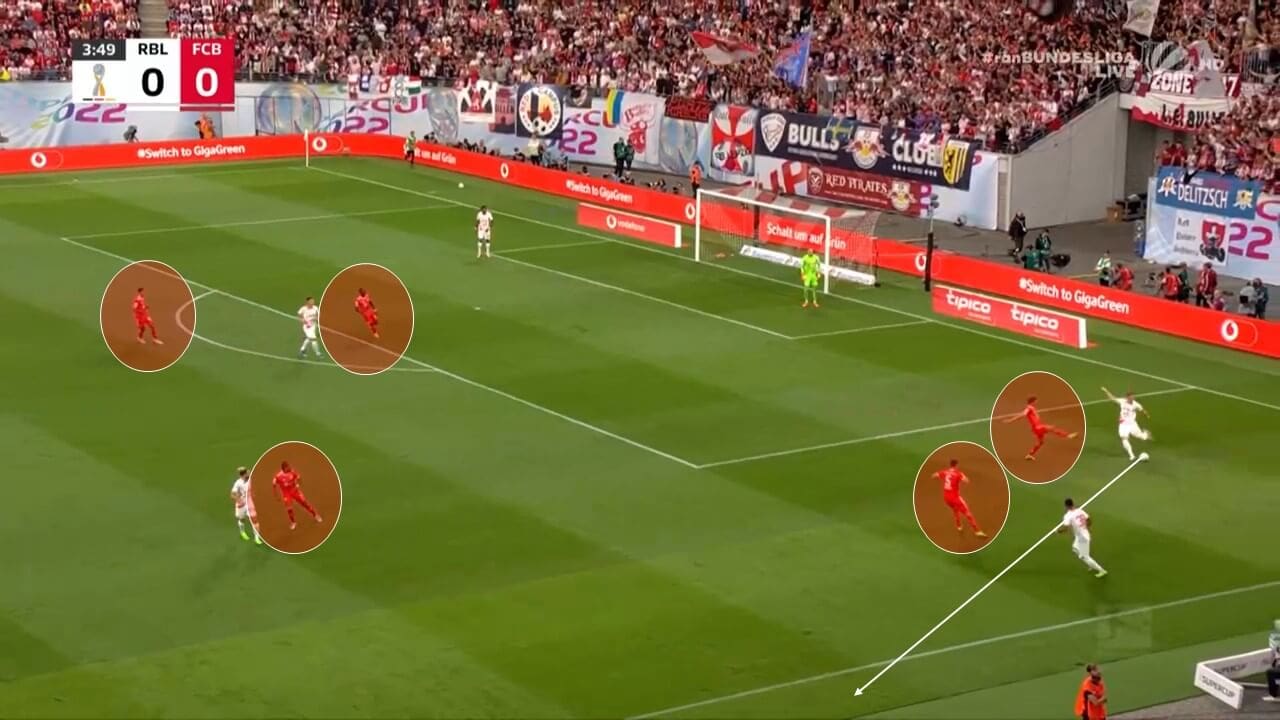
For Bayern, this allows them to force the opposition to make mistakes, starting an attack or keeping the pressure on the opposition. With the press, Nagelsmann aims to have relentless pressure on the opposition, never giving them time to relax in possession and be a constant threat out of possession.
The lack of a traditional number ‘9’ enhances the system Bayern look to play because of the players’ ability to interchange to cover for a teammate, while still being comfortable remaining in position when in possession. This requires a great intelligence of each position and good coaching to ensure the defensive structure is strong no matter who is in the defence.
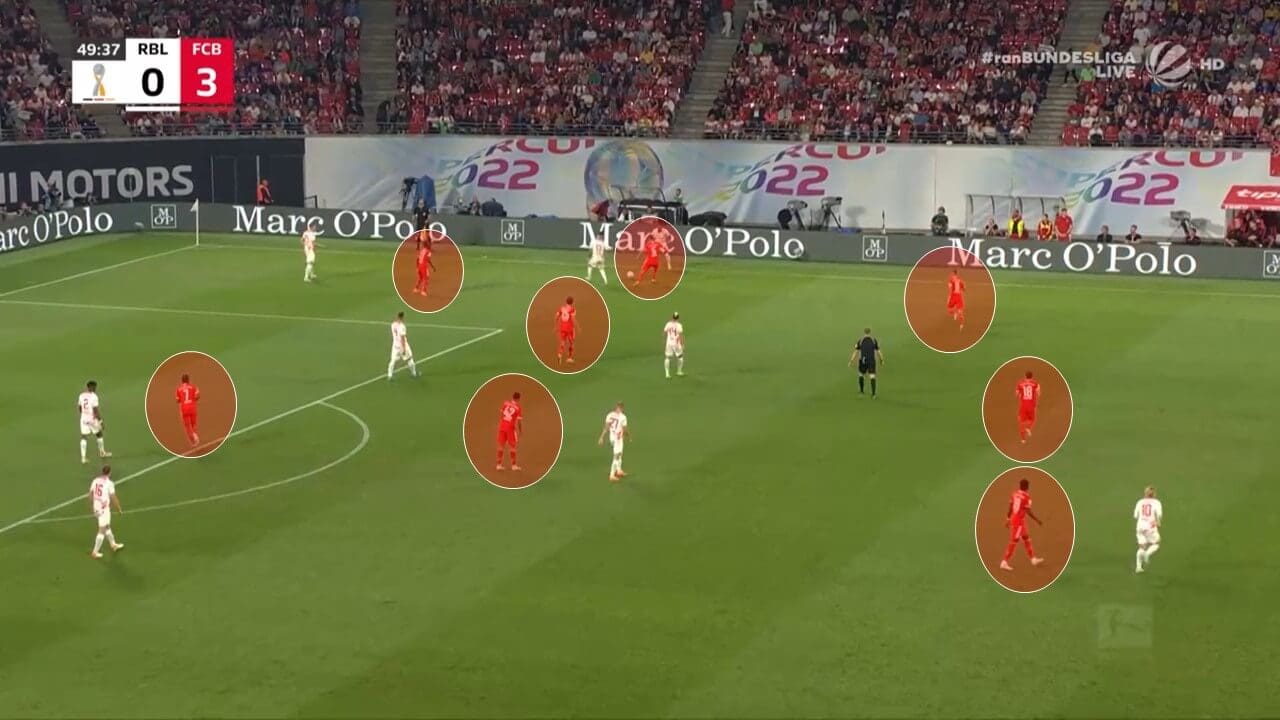
From the analysis of the image above, Bayern make the space compact around the ball by squeezing Leipzig to the touchline. Mane has moved into the wide midfield position while Gnabry occupies the number ‘9’ pocket. This allows Die Roten to lock in the opposition because more passing lanes are cut off.
Pavard has been given the license to push onto the wing-back, with Leipzig playing a 3-4-2-1, allowing Pavard to “cheat” by getting forward more than he typically would against a wide midfielder. Every player is crucial for this system to work and each player must buy into the philosophy for it to be effective. In the match, Bayern looked the fittest of the two sides allowing them to maintain the high-intensity press for the duration of the game.
Even in their own half, Bayern press with high intensity, maintaining compactness around the ball, limiting the opposition’s passing options and forcing them down the line. Closing the ball down in groups is why getting lots of players around the ball to press is so important for the system and why Nagelsmann would have focused on getting his players’ fitness up for the first game of the season.
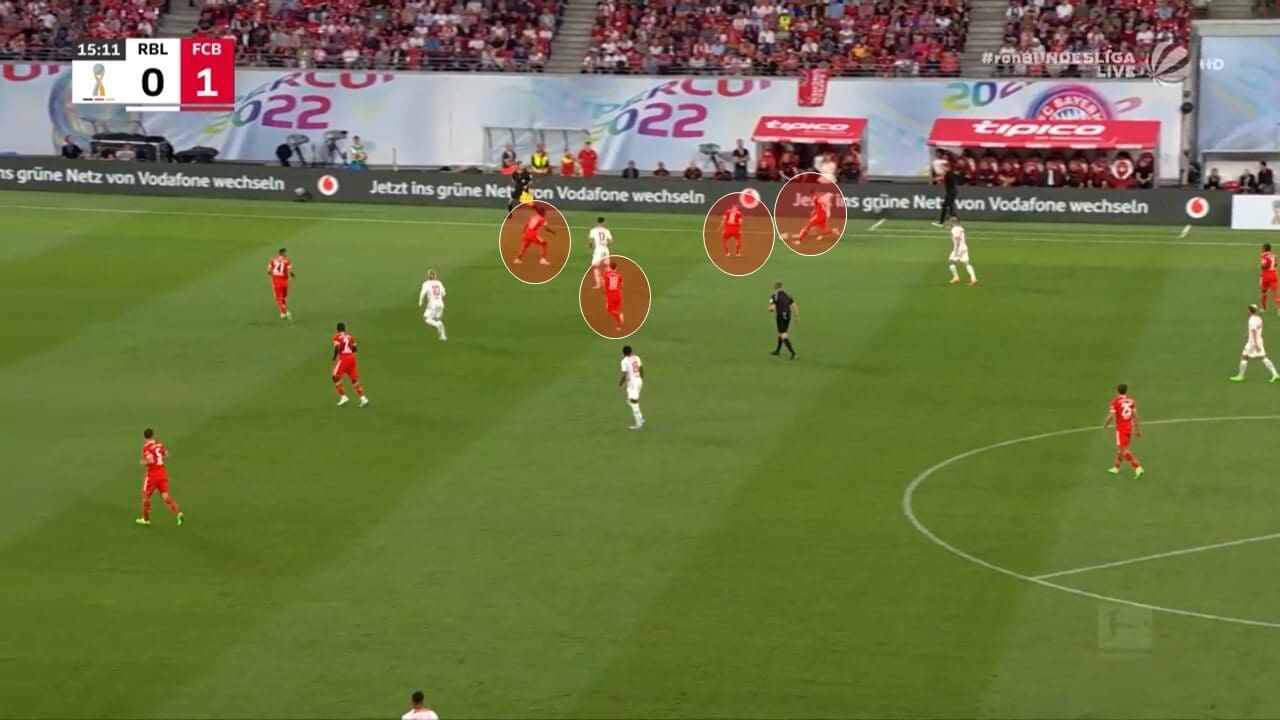
The high press from Bayern has clear drawbacks due to the lack of solidity in the defensive structure when caught on the break, but the press presents Bayern the opportunity to capitalize and force mistakes from the opposition. It is a brave tactic from Nagelsmann as the weakness in transition was the team’s biggest downfall last season and looked to still be haunting the system in the DFL-Supercup.
Transitions
Defence to Attack
Transitions are an essential part of a team with the ability to catch the opposition on the break, which Bayern constantly showcase with the pace in behind from Coman, Mane, Sane and Gnabry. Paired with the high press the pace to capitalise on the opposition’s mistakes, the transition from defence to attack is deadly to defend against.
Bayern were able to win the ball a few times to catch Leipzig on the break, with the most occurring in the first half. The best chance that Bayern created using these tactics was when Musiala sprinted from the left wing to pick Laimer’s pocket in the midfield.
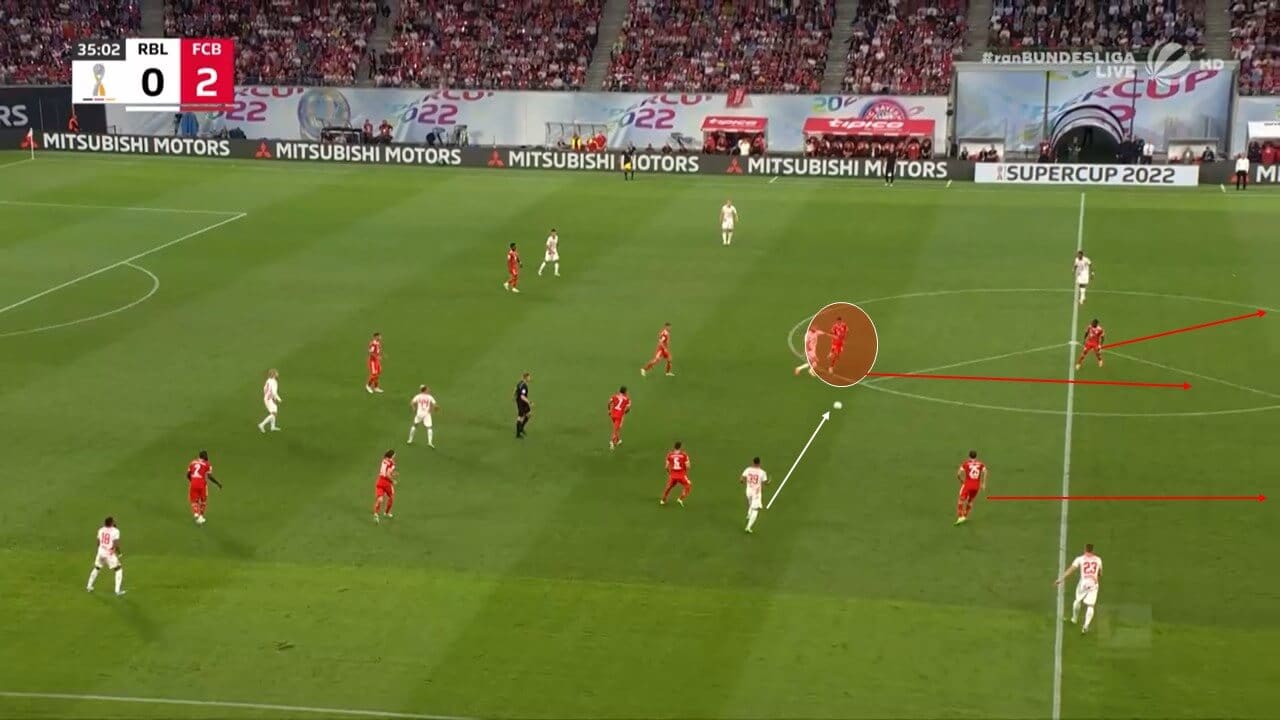
From here, Bayern instantly attacked Leipzig as bodies flooded forward for Die Roten. With Musiala driving forward, Mane and Müller aimed to get on the last man, giving the German youngster a quick outlet. Eventually, as the ball was carried to the edge of the box, Leipzig’s only option was to foul Musiala as he had wriggled away from three defenders, getting half a yard to play Mane in one-on-one with Willi Orban.
Bayern are always dangerous in transition from defence to attack, but their Achilles heel has always been when defending on the transition from attack to defence.
Attack to defence
The first problem Bayern ran into during the match was making mistakes in their own half, with 21 losses in their own third, 6 more than their average from last season. Multiple times, Bayern overplayed the ball getting themselves in trouble which is rare for a team with lots of quality in possession.
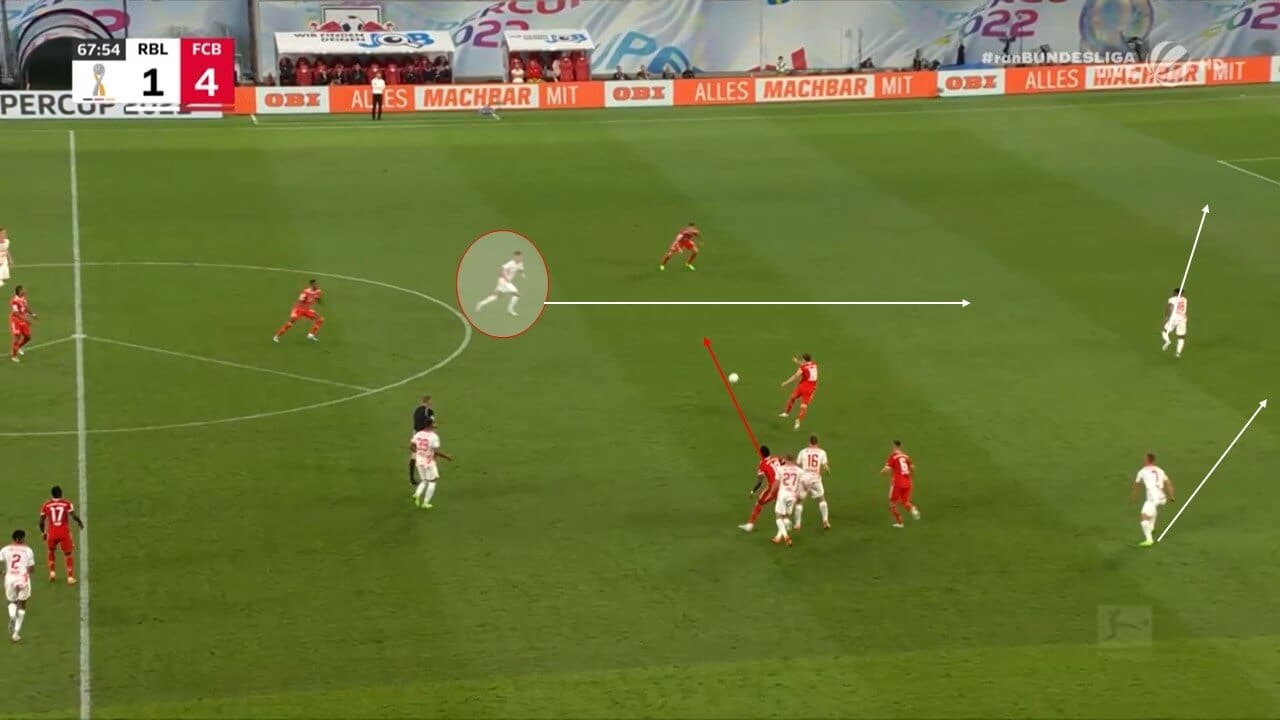
Once the ball had been turned over, Bayern were often unable to get the players back even when the midfield was busting a gut to get back. This is a weakness for every team that pushes a lot of players forward because they are then unable to recover.
The other instance where Bayern got caught in transition was after they had created a chance of their own in the 88th minute. Péter Gulácsi caught the ball and quickly distributed it to Laimer, who was free behind Bayern’s attacking line.
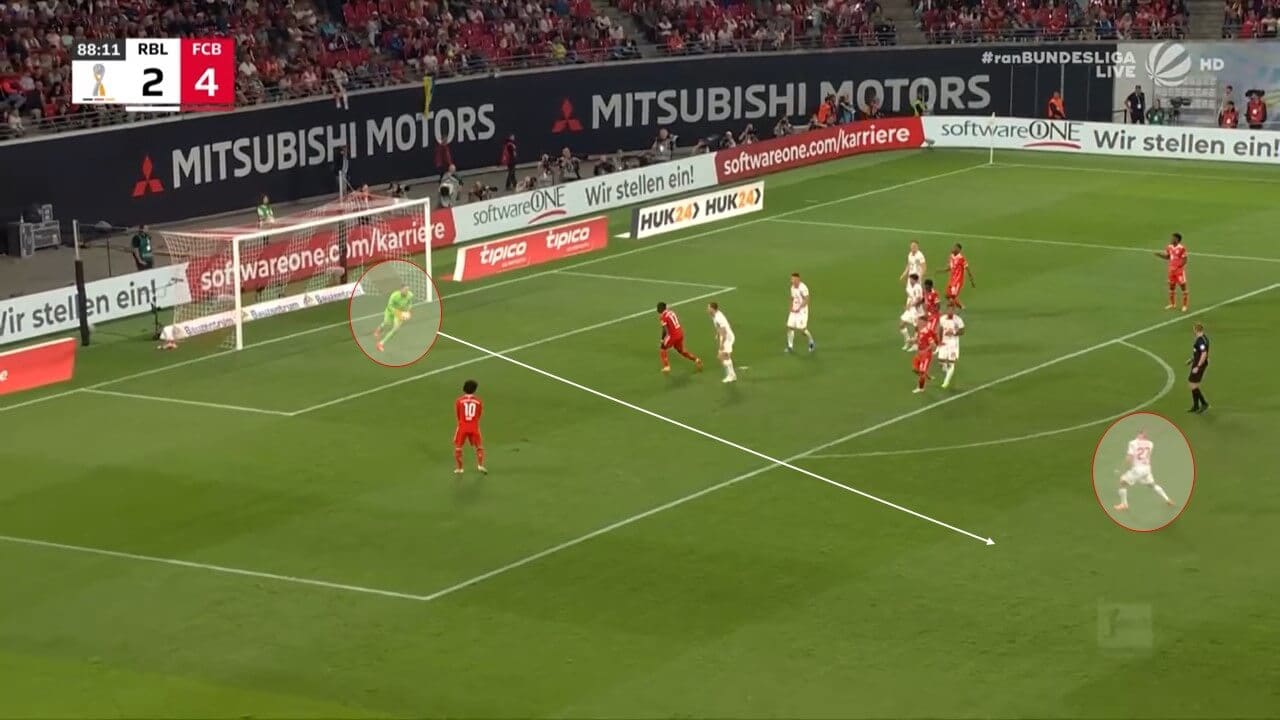
Having received the ball, Bayern now had 6 players out of the game, because they had sent so many players forward to overload the five defenders of Leipzig. Laimer got lucky to win two 50/50 challenges but he was then able to play the ball past a rushing Hernandez, who had committed to closing down the ball.
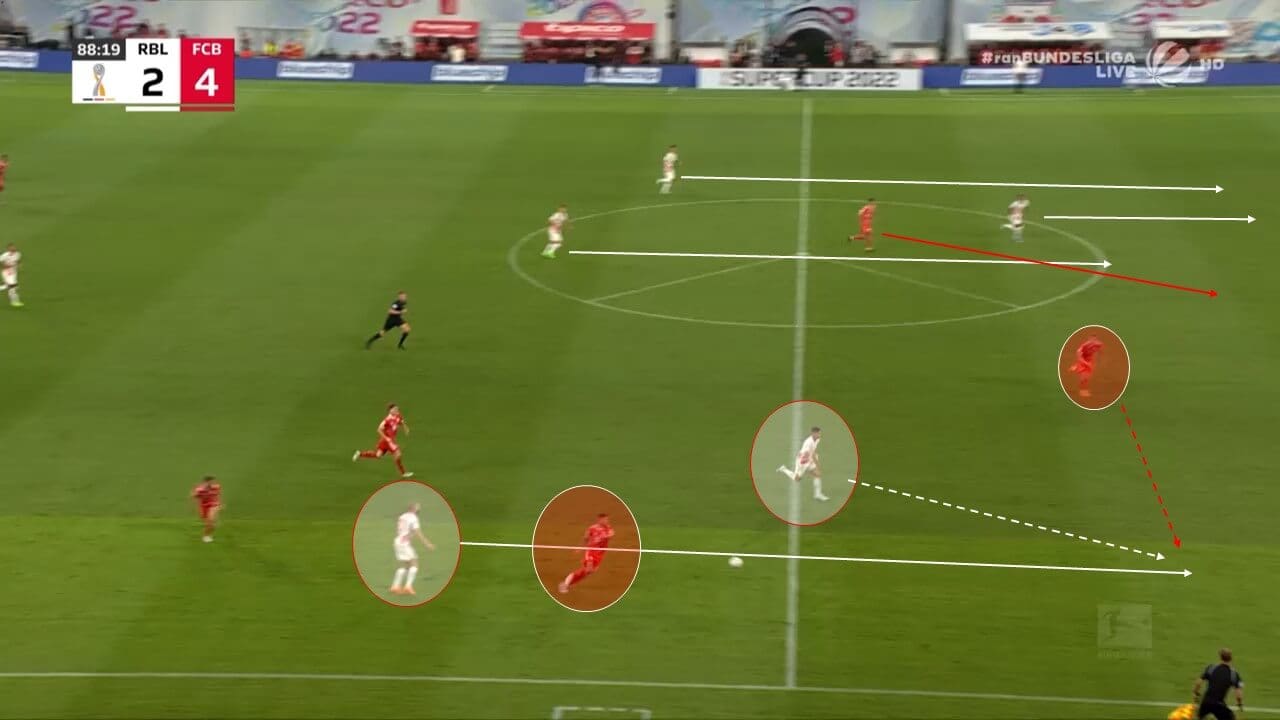
Now in a two-versus-two, De Ligt needed to slow down the Leipzig break by showing the attacker down the channel. However, an over-eager De Ligt was easily dribbled past with a simple change of direction. From here, the width of the Leipzig attack was then too much for Bayern to recover against, as Dani Olmo finishes the move with a tidy finish at the near post.
Nagelsmann has always had a problem against counterattacks but last season his squad were able to outscore the opponent to compensate for the weakness. Finding a solution will stem from the shape of the remaining players that stay back when Bayern are in attack and looking to set them up in a stronger structure.
The main worry for Nagelsmann will be negatively affecting his team’s attacking strength and high press for defensive solidity because these are key features that underpin his philosophy in and out of possession. If Nagelsmann can find a solution to this problem Bayern will be a serious Champions League contender, but if this issue remains, it may, once again, be their downfall against the best opponents.
Summary
There are no doubts that Bayern look just as or even more dangerous in attack than last season with the intensity and fluidity they possess with the squad. Their biggest weakness though is still the counterattack that exposes Nagelsmann’s brave tactical decision to flood bodies forward and around the ball.
Nagelsmann will have learnt a lot about his team from the DFL Supercup, but the reappearance of the demons from last season will be a concern for the German head coach. It will be interesting to see if Nagelsmann attempts to fix this problem for future matches or looks to change the system to provide more defensive solidity.
Bayern will travel to Frankfurt on Friday, August 5 for the first match in the Bundesliga season, which will provide another look at the system against a different type of opponent.






Comments